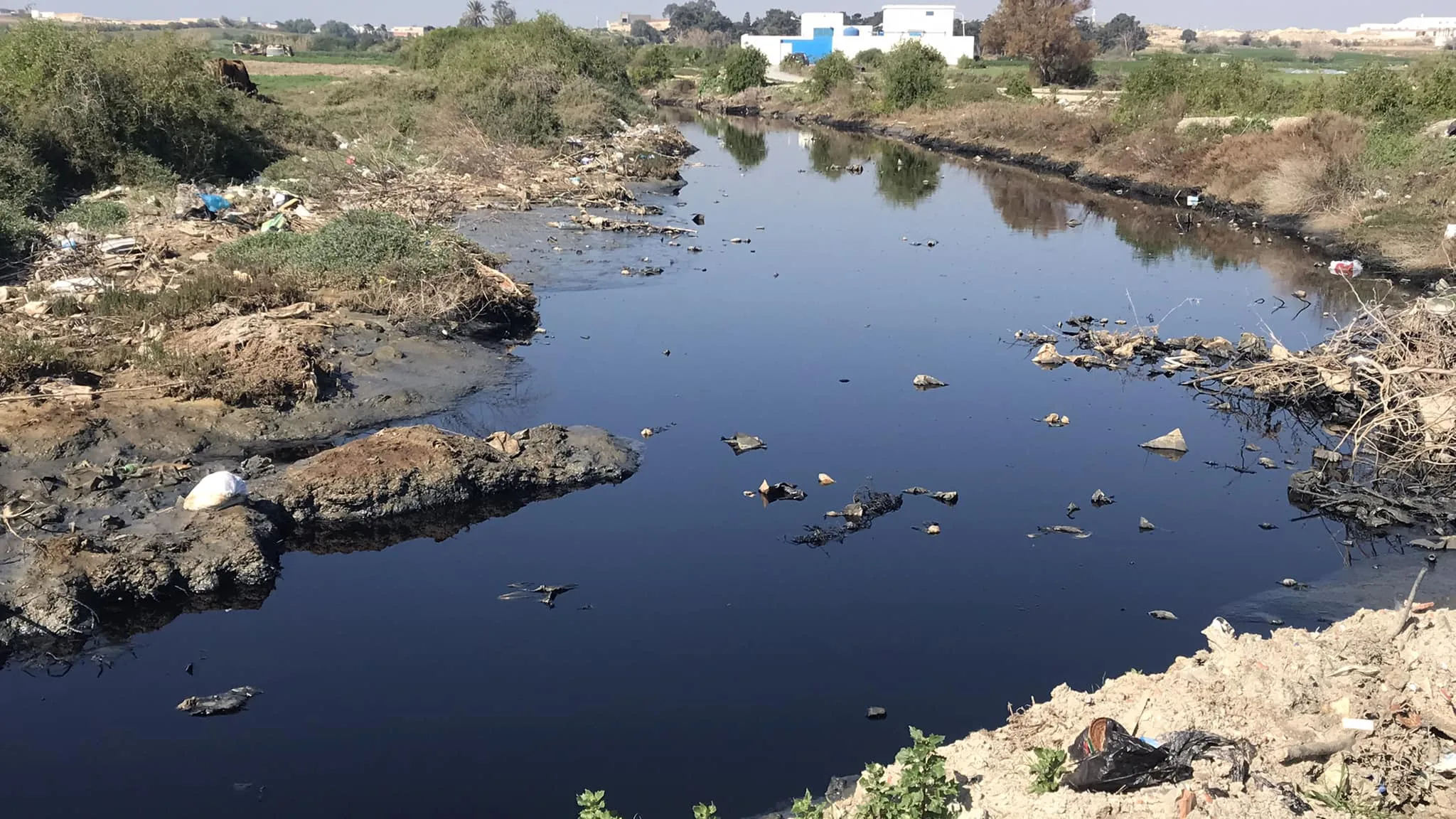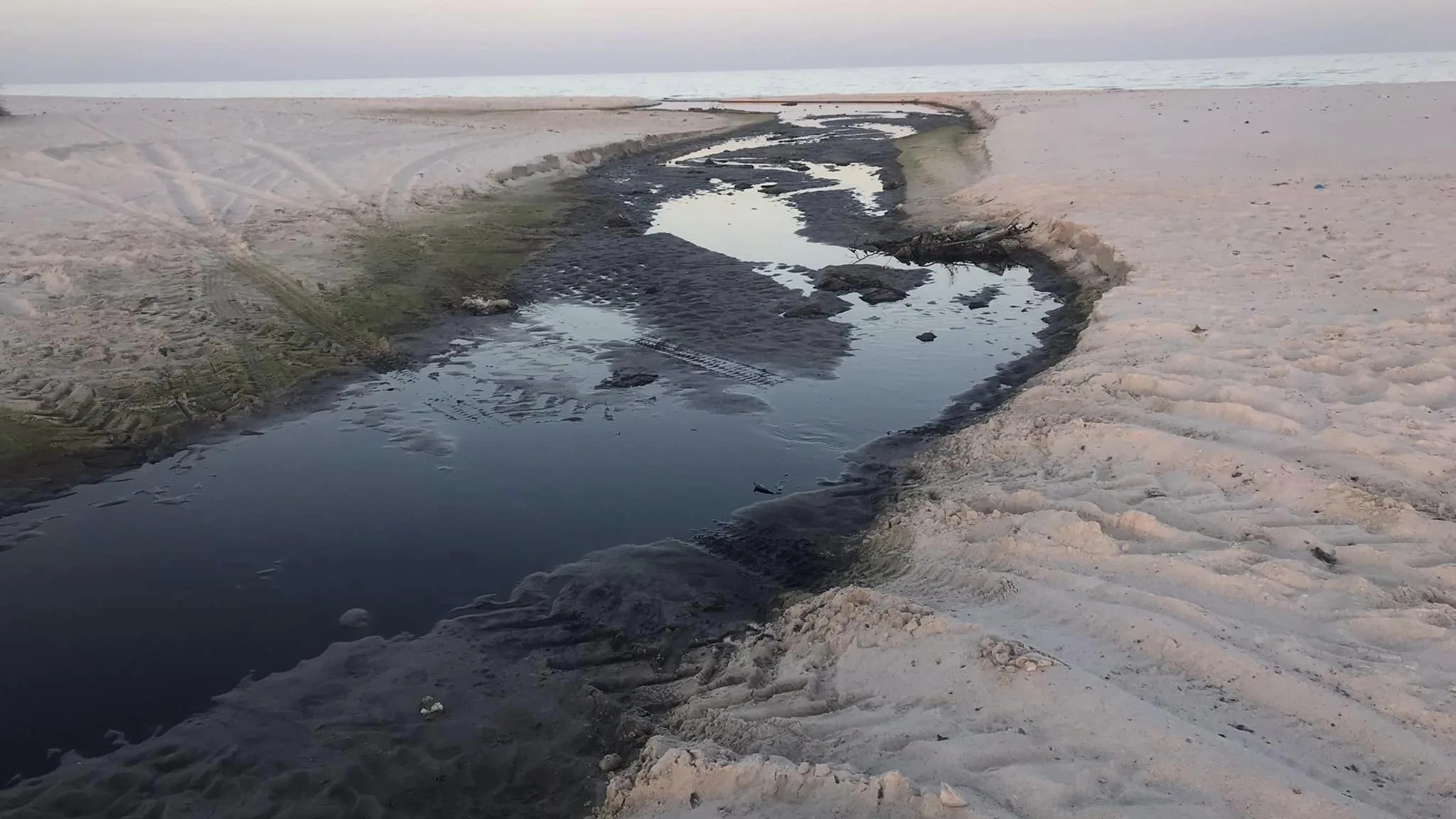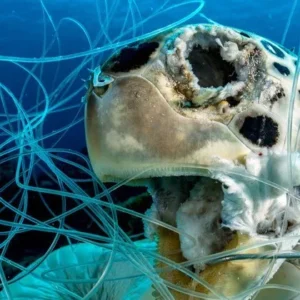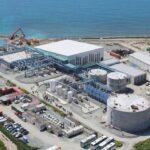Tunisia’s pollution crisis has reached an alarming level, with plastic waste choking and poisoning the seas, reckless dumping of industrial waste into hydraulic systems, and untreated sewage being relentlessly discharged, adding up to 276 million cubic meters of untreated water per year along the Tunisian coast. The National Sanitation Office (ONAS) is being blamed for mismanaging sanitation services and being held accountable for the catastrophic and unforgivable environmental disaster. This blatant disregard for the environment has turned the sea into a breeding ground for deadly bacteria and toxins, posing a significant threat to marine life, and spreading diseases that cause excruciating pain. Menzel Temim, a village located in the northeast of Tunisia, is among the worst affected areas, where the daily effects of pollution have led to a sense of despair and fear. The situation is dire and the fear of permanent damage to the environment and the health of the local population is a deeply concerning issue that cannot be ignored.
April 2023, Menzel Temim, Nabeul
A Village under siege: The alarming reality of Pollution in Menzel Temim
Menzel Temim, a small village located in the southeast of Tunisia’s Cap Bon peninsula, is under siege from a pollution crisis that has gone largely unnoticed. While the beach remains a popular destination for tourists and locals alike, the situation is far from idyllic. Reckless dumping of wastewater has led to a dangerous reality that threatens both the health of the local population and the environment. Aymen Hmem, a 42-year-old environmental activist and member of the Association of the Environment in Menzel Temim, has been fighting against this pollution crisis for years, driven by a deep sense of compassion for his community. “Our story with the wastewater pollution is a long and heartbreaking one, and I can speak about it for hours,” he laments. The reality is alarming, and the consequences of inaction could be dire, making the need for immediate intervention and solutions all the more urgent.
Our beach, once a source of joy, is now an eyesore. The once-clear waters are now murky and troubled. The stench of untreated waste is suffocating us, and the pollution crisis is taking a toll on the health of our people.
Aymen Hmem
Menzel Temim’s polluted sea: A Threat to Public Health and the Environment
The escalating pollution crisis in Menzel Temim is a result of the uncontrolled dumping of hazardous waste, a proliferation of unregulated landfills, and polluting industrial facilities, causing significant environmental damage and posing a grave threat to human well-being. The inadequate wastewater treatment facilities operated by the National Sanitation Office (ONAS) are among the main causes of pollution in the area. Despite treating all the used water pumped from the village of Menzel Temim, the station’s secondary treatment methods and treatment capacity of 8,283 cubic meters per day are inadequate. As a result, the treated wastewater is discharged into the Oued of Mrigueb, which eventually flows into the sea, leading to significant environmental damage. Contaminated water is affecting local ecosystems and posing a grave threat to the health of the population. Immediate action is crucial to mitigate the damage caused by this crisis and to ensure the long-term health of the environment and the community.
I vividly recall that one fateful summer day when dozens of innocent people, including children, were infected with eye and skin problems, and suffered from gastric issues after swimming at the beach. The image of the hospital, where they were helpless and in pain, still haunts me to this day. We are the victims of these horrific crimes, and our children and families continue to suffer. The overwhelming sadness and despair that we feel cannot be put into words. We demand accountability and justice for those responsible for this environmental disaster that has destroyed our beloved Mnzel Temim
A.Hmem

The pollution crisis in Menzel Temim is a complex issue, with various factors contributing to the problem. The National Sanitation Office (ONAS) operates wastewater treatment facilities that use only secondary treatment methods and have a limited treatment capacity, exacerbating the pollution problem. The local population’s continuous growth further amplifies the issue, as the facilities are not capable of treating the volume of wastewater generated effectively. The industrial facilities in the region are also a significant source of pollution, discharging untreated wastewater into the public canalization system, which lacks proper treatment systems. Thameur Jaouedi, Director of Wastewater Treatment Valorization at ONAS, highlights the illegal practices held by certain industries, which have led to significant environmental damage, soil contamination, and contamination of water. These practices pose a serious threat to the health of the local population and the surrounding biodiversity. Immediate action is necessary to address these issues and ensure a sustainable future for the community and the environment.
According to Thameur Jaouadi, Director of Wastewater Treatment Valorization at ONAS: “The standard used for wastewater treatment in Tunisia is the NT106.02 standard, which is a strict standard that takes into account various parameters, including BOD5 (Biochemical Oxygen Demand), COD (Chemical Oxygen Demand), heavy metals, suspended matter and bacteria. This standard is designed to ensure that the treated wastewater meets the required quality standards before being discharged into the environment. Unfortunately, the majority of people judge the treated wastewater discharged by ONAS wastewater treatment plants based solely on its appearance, without considering the quality of the water that enters the treatment plants or the necessary analyses that must be performed.”
Unfortunately, ONAS is often blamed for the poor quality of the treated wastewater, despite being a victim of its input.
T.Jaouadi

Thameur Jaouedi, Director of Wastewater Treatment Valorization at ONAS, has identified a major contributor to the pollution crisis in Menzel Temim: certain industrial facilities that engage in non-compliant and anarchic practices for collecting and disposing of their wastewater. The wastewater entering the treatment plants contains clandestine discharges from these unregulated industrial facilities, which use collection tanks filled with contaminated water from factories, oils, and various pollutants. These facilities are responsible for depleting the groundwater table and discharging untreated wastewater into the public canalization system without proper pre-treatment stations to ensure compliance with the required collection standards.
“We have a shared responsibility for the quality of water entering the public canalization system, which is managed jointly by ONAS and the National Agency for Environmental Protection (ANPE). In case the water quality is poor, we are obligated to take action and address the issue. We acknowledge our responsibility in this matter and we are committed to taking all necessary measures to ensure that the water entering the treatment plants is of the required quality and that the treated wastewater discharged into the environment meets the required standards,” affirms Thouraya Hergli, communication officer of ONAS.

According to Aymen Hmem: “The unregulated industrial zone is continuously discharging untreated toxic waste into the Oued 3aamoud of Menzel Temim, which is illegally connected to ONAS’s canalization system. As a compassionate community association, we have made every possible effort to defend our village and our environment, but it has become an excruciating struggle. Despite filing numerous complaints and sending heartfelt letters to our local authorities, our voices are being ignored, and the situation is becoming unbearable. Even when a wastewater treatment plant breaks down, it takes weeks to repair, and the consequences weigh heavily on our environment, which is slowly suffocating before our eyes… until when?”
The root causes of pollution related to wastewater treatment
According to the “State of the Environment in Tunisia” report published in 2022 by the Tunisian Forum for Economic and Social Rights, a significant portion of wastewater produced in Tunisia, around 70%, is discharged directly into the environment without undergoing adequate treatment, posing a serious threat to human health and the environment. “Approximately 276 million cubic meters of treated water are discharged annually into the Tunisian coastal areas. However, to identify the root causes of pollution, detailed studies are required that take into consideration all potential sources of pollution or activities in the area being studied, including agriculture, industrial activities, the watershed, and the estimation of the load that may be drained by water points and rivers.” Reclaimed Noureddine Zaaboub, a researcher at the National Institute of Marine Sciences and Technologies (INSTM).
The issue of pollution in Tunisian coastal areas is a complex problem that requires a comprehensive approach to understand and address. While ONAS’s discharges into the coastal waters are a significant contributor to pollution, the quantification of pollution should also consider other sources of contamination generated by activities in the vicinity, as well as climatic factors, such as lixiviation* that can transport significant amounts of soil into aquatic environments. Conducting detailed studies that take into account all potential sources of pollution and the impact of climatic factors is crucial to understanding and addressing the issue of pollution in Tunisian coastal areas.
Noureddine Zaaboub

Based on the data provided by its official website, the ONAS system is equipped with a total of 125 wastewater treatment plants, of which only 25 are tertiary treatment plants, which highlights the limited number of tertiary wastewater treatment plants in the ONAS system and emphasizes that a significant portion of the treated wastewater may still contain some level of pollutants that can potentially harm the environment and human health. According to the Institute of Strategic Studies report, the compliance rate for treated wastewater by treatment plants is 73%. However, as stated by Thameur Jaouadi, the majority of non-compliance cases are caused by inadequate maintenance and operation of the treatment plants, which can result in equipment failure. Overloading of the treatment plant is also a common cause of pollution. If a treatment plant is designed to treat a certain volume of water but is overloaded due to increased demand or discharge of untreated wastewater from unregulated and anarchic areas, it can result in decreased treatment efficiency and increased levels of pollutants in the treated water.
Toxic Waters Drowning into the Sea: The Silent Killer of Biodiversity and aquatic ecosystems
As described by Aymen Hmem, the natural ecosystem in Menzel Temim is being adversely affected by illegal activities and infractions that are causing harm to biodiversity and threatening the lives of various living organisms in these natural areas. “While human health is undoubtedly important, it is equally vital to acknowledge the significance of zoosanitary health, which can be endangered by pollution from contaminated waters. As Monia Elbour emphasizes, humans are just one part of the larger ecosystem, and their actions can have a profound impact on the health of other living organisms.”
“Our coast has undergone significant changes over the years. It used to be a common practice for locals to enjoy pleasure fishing, and diving deep to explore the beauty of our seabed, where we could easily witness the rich biodiversity and benthic plants. But now, it’s like observing a barren desert. Everything is brown. Even when you swim, a slight movement with your feet stirs up fecal waste, making the water turbid and emitting a foul odor. How can any living aquatic organism survive in such polluted waters? How can traditional fishermen continue to fish in such an environment?” Laments Aymen Hmem.
As stated by Noureddine Zaaboub, if treated water is not properly treated before being discharged into the sea, it can have significant negative impacts on marine ecosystems, including the loss of biodiversity. This is due to the presence of pollutants in the treated water which can harm or kill marine organisms and disrupt the delicate balance of the ecosystem.
According to Monia Elbour: “Various types of pollutants, whether chemical or biological, can be found in wastewater. Bacteria, in particular, pose a significant problem because their survival form when discharged into the natural environment is viable and non-cultivable. This form, similar to a cyst, can maintain its virulence and pathogenicity, and even multiply as an opportunistic germ. These forms must be considered in wastewater treatment systems because if the water is loaded with these bacterial forms and discharged into natural environments where biodiversity is present.”
This damage may include a decrease in the biodiversity index, which could lead to the proliferation of more resistant species and the elimination of sensitive ones. This, in turn, could result from the degradation of habitats and the disruption of ecological processes that are crucial for maintaining a healthy and balanced environment.
M.Elbour
According to the statements of Noureddine Zaaboub, in areas where there is a substantial input of organic matter, eutrophication can occur, which is a process characterized by excessive growth of algae and other aquatic plants. This growth can lead to a decrease in oxygen levels and degradation of water quality, ultimately resulting in harm to aquatic life.
The natural aquatic ecosystem is in a delicate balance. When excess nutrients such as phosphorus and nitrogen are introduced into the ecosystem through untreated waters released in the aquatic biotope, it can lead to the dystrophy of the aquatic environment and the growth of toxic phytoplankton species. These species can release toxins that can harm or kill fish, degrade biodiversity, and disrupt the reproduction of aquatic organisms, ultimately leading to an imbalance in the aquatic environment.
M.Elbour
Towards a circular economy in Tunisia: leveraging the Potential of treated wastewater
Tunisia has made some progress in valorizing treated water, but the potential of treated wastewater is still largely untapped. According to the national report on the water sector published by the Ministry of Agriculture, Water Resources, and Fisheries, the estimated potential of treated wastewater is around 300 million cubic meters per year, while only 7% of the total treated volume is currently reused. This highlights the urgent need for the National Sanitation Office (ONAS) to improve its treatment methods and increase the reuse of treated wastewater, as well as to explore more effective methods of valorization.
To achieve this goal, the role of associations, civil society, and scientific research is crucial in driving change and promoting more effective methods of valorization. While ONAS has started some valorization initiatives, the approach of industrial ecology can also be proposed to create a closed-loop system where waste from one industry becomes a resource for another. By adopting this approach and other innovative solutions, we can work towards a more sustainable and circular use of resources.
*Lixiviation: a process by which water or another solvent extracts soluble substances from a solid material or soil. This process occurs when water percolates through the soil, dissolving and carrying away soluble nutrients, minerals, and pollutants.
Credit cover photo: Image © Shutterstock / JonShore
This article was developed in collaboration with the Earth Journalism Media Mediterranean Initiative project.
Sources:
- http://www.onagri.nat.tn/uploads/Etudes/Revue_2020_final.pdf
- https://ez5-projets.ifremer.fr/simm_en/Nos-rubriques/Etat-du-milieu/Eutrophisation
- https://ftdes.net/rapports/environnement2022.fr.pdf
- http://www.onagri.nat.tn/uploads/Etudes/Revue_2020_final.pdf
- http://www.onas.nat.tn/Ar/region.php?code=6&code_region=23#
- https://nawaat.org/2022/08/25/mer-en-peril-attention-excrements-et-dechets-industriels/?fbclid=IwAR2eXnWNSmfsNGZTzV_UZk94hYuL_AXfZGz2M_Zg-MlueG-mWQdGIncAmU0
- https://inkyfada.com/fr/2021/10/08/pollution-banlieue-sud-tunis-mer-plage-analyses-eaux-usees-onas/
Copyright © 2022 Blue Tunisia. All rights reserved














